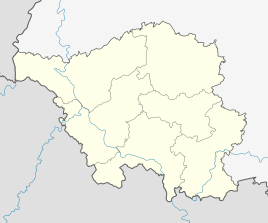Emmersweiler
|
Emmersweiler
Community Großrosseln
|
||
|---|---|---|
| Coordinates: 49 ° 10 ′ 49 ″ N , 6 ° 51 ′ 21 ″ E | ||
| Height : | 200 m | |
| Incorporation : | 1st January 1974 | |
| Postal code : | 66352 | |
| Area code : | 06809 | |
|
Location of Emmersweiler in Saarland |
||
Emmersweiler is a district of the community Großrosseln in the Saarland regional association Saarbrücken . Until the end of 1973 Emmersweiler was an independent municipality.
history
The first records of Emmersweiler date back to the 14th century, but a settlement must have existed long before that. 1345 gave John of Bénestroff of Abbey Wadgassen 32 Schilling Metzer currency "in Emmer hamlet". Before 1633 there is hardly anything to be found in the records about the residents, only that one resident owned "Pfennert Wiesen in Emmersweiler". The residents lived by working in the forest, tying brooms, and farming and raising animals. In 1640 famine and plague as a result of the Thirty Years' War had killed the residents. Only a heap of rubble remained of the place. Reconstruction only began at the end of the 17th century. The Folklingen church books report that in 1691 some families lived in Emmersweiler. The list of residents is continued by name until 1791. The princely government concluded an exchange agreement with the French government in 1768, whereby French territories with Emmersweiler passed into the possession of the county on October 26, 1770. Prince Ludwig von Nassau-Saarbrücken (1768–1794) ordered a division of the arable land and the meadows. Thus, the villagers were in the agriculture up some work done.
In 1798 Emmersweiler came under French rule , which lasted until 1814. Prussia took over the area in 1815 and the village was able to develop undisturbed for a long time. Another flourishing began after the Stieringer ironworks was built in 1847 and the coal mines were put into operation. The construction of the Großrosseln-Saarbrücken railway line and the Kleinrosseln-Forbach tram line after 1909 brought advantages for Emmersweiler. Emmersweiler developed rapidly in the period that followed.
As part of the Saarland regional and administrative reform , the previously independent municipality of Emmersweiler was assigned to the municipality of Großrosseln on January 1, 1974.
A partnership with the neighboring French community of Morsbach has existed since 1993 .
Population development
| year | Residents | source |
|---|---|---|
| 1815 | 160 | |
| 1858 | 326 | |
| 1900 | 474 | |
| 1922 | 835 | |
| 1961 | 1300 | |
| 1970 | 1425 | |
| 2015 | 1007 |
Catholic Church of St. Barbara
Today's Catholic Church of St. Barbara is the second successor to the church built in 1733 and restored in 1844 by the municipal master builder C. Hild from Saarbrücken, which was replaced for the first time between 1882 and 1883 by the then municipal master builder Reinhold Wirtz and after extensions by the architect J. Trenz from Völklingen in 1949, 1960 due to dilapidation, was closed.
From 1965 to 1967 the church was built according to the plans of the architect Günter Kleinjohann . The artist Hanns Scherl from Wittlich brought in bronze work and Ferdinand Selgrad's design for the concrete glass windows was carried out in 1966.
Web links
Individual evidence
- ↑ New Structure Act - NGG of December 19, 1973, Section 3, published in the Saarland Official Gazette 1973, No. 48, p. 853 (PDF page 25; 499 kB)
- ↑ a b c Federal Statistical Office (ed.): Historical municipality directory for the Federal Republic of Germany. Name, border and key number changes in municipalities, counties and administrative districts from May 27, 1970 to December 31, 1982 . W. Kohlhammer, Stuttgart / Mainz 1983, ISBN 3-17-003263-1 , p. 806 .
- ↑ a b c d Website of the community Großrosseln, there> Citizens Service> Community Districts> Emmersweiler
- ^ Community development concept (GEKO) , accessed on May 9, 2019
- ^ Church of St. Barbara - Emmersweiler , accessed on January 26, 2014

